10.19.2021
By uscbknpt
Class of 2021 Graduate Profiles
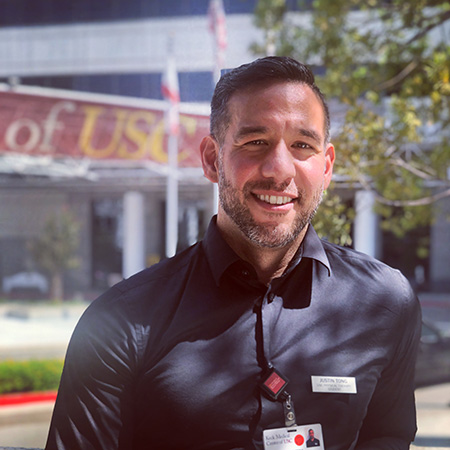
EACH DAY, in the lead up to Commencement, we highlighted one of the members of the graduating Class of 2021. Scroll down to meet some of our students who recently tossed their mortarboards into the air.
Justin’s Second Act
At 40, and after a number of careers, Justin Tong has found his calling and is ready to use it to improve others’ lives through physical therapy.
BY JAMIE WETHERBE MA ’04
May 14, 2021
JUSTIN TONG DPT ’21 HAS SHIFTED CAREERS SEVERAL TIMES since graduating high school. “I’ve been a pig farmer, a plumber, a Hula dancer, a chocolatier — there have been a lot of paths that led me to this one,” says Tong, a DPT student on the hybrid pathway set to graduate this spring.
Tong later found his focus in the fitness industry working as a personal trainer for nearly 20 years.
People recovering from injuries, including those who had just finished physical therapy, became part of Tong’s main clientele.
“I really enjoyed the format of that fitness,” he says. “I developed a niche working in corrective exercise-type of training.”
About seven years ago, Tong, then 33, decided to make another career leap: to go back to school to become a physical therapist. “I’ve always been interested in anatomy and movement,” says Tong, now 40. “It just took me a little bit longer to find that interest.”
Being older than most of the students in his DPT program earned Tong a unique nickname. “They call me ‘Dad,’” he says. “And I’m totally OK with it — I own it.”
Tong also owns the life experience he’s bringing to his education this time around, including under-standing the of amount of work and dedication it takes to succeed.
“I’ve gone through those younger years, when maybe you don’t put as much effort into things as you probably should,” he says. “Now, I have the motivation and direction, without the distractions.”
The road to his degree came with several challenges that called for careful planning and budgeting. “I went from having an adult paycheck to living like a student,” he says. “But all the effort and stress to get here was totally worth it.”
Defining Moments
From all-night study groups to invaluable guidance from faculty, Tong had many memorable moments at USC. A standout experience was a service-learning trip to Gabriel House, a nonprofit rehabilitation center for children with disabilities.
Tong, along with other USC students and faculty, traveled to Ensenada, Mexico, to provide physical therapy treatments. “It was an eye-opening experience,” Tong says. “Many of the children had disabilities that were pretty severe, and [Gabriel House] doesn’t have a lot of funding.”
Tong and the team taught caregivers exercises to address the unique impairments of each child, and used whatever they could find to improve equipment, including adjusting second-hand wheelchairs.
“We rigged some of the wheel chairs so they were properly angled and locked them in place by hammering,” Tong says. “We also tightened cushions by sewing them together with shoe strings.”
The experience further reinforced that Tong had found his calling. “It showed how much benefit we can have in the lives of our patients, and made what we do as physical therapists even more of a passion for me,” he says.
Group Together
During his time at USC, Tong earned a scholarship for scholastic excellence and was involved in several organizations, including serving as a student leader for the LGBTQQIA+ Affinity Group.
The group, which formed over the summer, aims to provide more visibility among the LGBTQQIA+ community, offering incoming students a safe place to talk, connect and socialize.
Following last summer’s Black Lives Matter movements, affinity groups across the college came together to support each other. “We created groups where we could unload and learn, and discuss ways we could help those within minorities feel more welcome, included and safe,” Tong says.
Tong plans to continue giving back after graduation. “I definitely want to stay involved with the USC family in whatever capacity I can,” he says.
As for what’s next, Tong, who soon starts his USC orthopedic residency, plans to return to his roots in fitness. “I want to open my physical therapy practice specializing in orthopedics and sports [medicine],” he says. “That’s going to be a while, but it’s on my radar.”
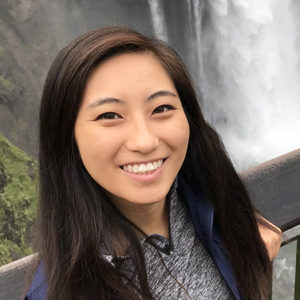
Making an Impact
Her grandparents focused on survival, her parents focused on making a stable life in a new country, now Emma Wong is focused on making a difference in the lives of others.
BY JAMIE WETHERBE MA ’04
May 14, 2021
Emma Wong DPT ’21 is set to graduate this spring with an impressive list of achievements and accolades, from earning service and multicultural leadership scholarships to volunteering with several underserved communities.
“To be honest, I didn’t know physical therapy was the career for me until my second year of PT school,” she says.
During finals week of her first year at USC, Wong’s grandfather passed away from complications of lung cancer. “There were definitely challenges and a lot of questions I asked myself about what more I could have done to help him,” she says.
By taking classes in cardiopulmonary pathology and management, she learned how physical therapists can make a difference in people’s lives, including those experiencing the same symptoms as her grandfather.
“Each lesson I would think, ‘Wow, PTs can do that?’ Or ‘Wow, this is how we can help?’” she says. “It really showed that we as PTs can still make that positive impact throughout the spectrum of life and disease progressions. It also motivated me to continue making that impact for others and their loved ones.”
A Perfect Fit
During her time at USC, Wong volunteered for several organizations, from the Interprofessional Geriatric Curriculum (IPGC) to the Wiengart East L.A. YMCA Food Assistance Program.
Wong also served as a volunteer coordinator for USC Fit Families, a free fitness and nutrition program for local underserved children at risk for diabetes, hypertension and other conditions associated with physical inactivity.
“I noticed when touring physical therapy schools that there were a number of hospitals and campus-es surrounded by low-income and underserved areas,” she says of her interest in the program. “I wanted to understand that connection better and help provide a bridge to that care.”
In addition to reaching participants near campus, Wong helped coordinate the transition of Fit Families from in-person to online, making the program even more accessible.
“It’s been amazing to see our participants grow individually in their own health journey and to watch our program reach so many people,” Wong says.
Drive for Diversity
Wong worked in other ways to make the profession inclusive, including leading presentations about physical therapy careers to underserved high school students and serving as co-president of the Physical Therapy Multicultural Leadership Association.
“If physical therapy is not accessible to diverse communities, how do we expect the future generations to know about the profession and its benefits?” she says.
Wong experienced first-hand how lack of availability and diversity among providers can affect quality of care.
“Growing up, I was deemed the ‘chauffeur’ and drove my grandparents to their [medical] appointments once I had a license,” she says.
Often the greatest barrier to care was finding clinicians who could explain concepts in Cantonese, Wong says.
Wong saw similar obstacles during clinical rotations, including when care was delayed because interpreter services weren’t unavailable.
“One of my clinical instructors said to me that the progress of patients is really reflective of the physical therapist,” Wong says. “If patients find it difficult to relate or understand their therapists, that decreases accessibility to that care.”
Wong confronted several challenges on her road to her degree, particularly as the world went through unprecedented upheaval. The recent uptick in violent Anti-Asian attacks was extremely difficult.
“I went from the confusing experience of microaggressions to the very frightening reality of macroaggressions,” Wong says. “I felt further challenged to understand my feelings, but also balancing between educating others, as others have done for me, and holding a healing space for myself.”
Wong served as a student leader in the Asian Pacific Islander Student Affinity Group to help facilitate discussions between faculty and students surrounding the Asian and Asian-American experience.
“This has been an interesting experience to navigate in my own individual journey, as well as professionally, when addressing those who have traditionally been my professors or mentors,” Wong says.
As for what’s next, Wong plans to continue serving those in need, a value that’s part of the fabric of her family.
“While discussing my grandparents’ journeys to America and my parent’s childhood experiences, my dad and I got on the topic of what my purpose was in life,” she says. “He stated, ‘Well, your grand-parents focused on survival and immigrating; we focused on creating a stable life in this country; so now you have the energy to focus on making an impact in your life or someone else’s.’”
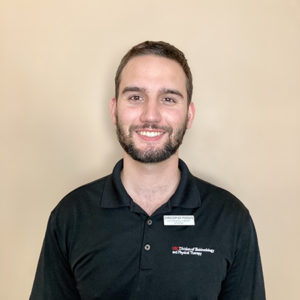
From Patient to Practitioner
Having suffered a serious spinal cord injury as a teen, Chris Pierson has seen firsthand the impact good physical therapists can have on their patients and hopes to do the same for others.
BY KATHARINE GAMMON
May 12, 2021
CHRIS PIERSON DPT ’21 CAN’T PINPOINT THE EXACT MOMENT HE KNEW he was destined to become a physical therapist, but he knows roughly when he became interested.
At the age of 16, Pierson suffered a serious spinal cord injury while skiing. Finding himself suddenly paralyzed from the waist down, Pierson spent nearly two months in an inpatient rehabilitation hospital. At the time, all he wanted was to get out of bed and resume his life as a teenager, but first he had to relearn how to stand and walk.
Over the next six years, Pierson worked with seven physical therapists, both in the hospital and in outpatient settings in two different states. “Somewhere along the way, my physical therapist pointed out that I could do this as a career,” he says.
Getting back on his feet was a long process. First, the high school student began by standing within parallel bars with his therapists. Next, he began taking steps with a walker, then a cane, and finally, at graduation, he was able to cross the stage on his own.
By then, he was hooked on the idea of physical therapy as a career. After graduation, he set out for The Ohio State University, where he majored in exercise science and minored in social psychology and personality — with the idea that it would improve his ability to connect with others.
Even though he was walking again, his body was still slowly recovering — and during his four undergraduate years, he continued with outpatient physical therapy. It was one of the hardest times of his life. “My first two years of undergrad were hard because I had extremely poor endurance,” Pierson says. “I was still dealing with the injury and also trying to fit in as a normal undergrad student in a new state.”
Giving Back to the Community
When he arrived at USC, Pierson dove into community service as well as his studies.
While riding BMX bikes at the skateparks in East Los Angeles, he met some friends who had no idea about physical therapy. He knew that the community needed help and access, so he co-founded the Student Run Clinic Wellness Center site, a pro bono clinic that offers free healthcare screenings and personalized advice to East L.A. residents.
As the Wellness Center site liaison, he was the one primarily responsible for organizing all of the student volunteers and licensed preceptors from multiple disciplines. Physical therapy had not previously been part of the organization, and Pierson wanted to show that DPT students could be just as involved at the organizational level as pharmacy or medical students. “I wanted to provide physical therapy to people who otherwise weren’t going to get it,” he says.
Finding his Footing
These days, Pierson has only a few lingering issues as a result of his skiing injury. “I don’t have any issues practicing as a PT, but I still have a hard time walking long distances, and there are certain areas of my body that are still very weak.”
Looking back, Pierson didn’t expect he would be at the level he is at today. He remembers clearly the months when it looked very unlikely that he would even be able to walk independently.
The experience has left him stronger in his resolve — and armed with tools to be the best physical therapist he can. “I have learned a lot about how to work with patients. I could see how my therapists did things and see what things they did I liked, and that has helped me a lot now in working with my own patients,” he says. “I learned a lot about different exercises and treatment programs from having to physically do it all myself.”
Healing Others, Healing Himself
During his last acute care rotation at Keck, Pierson was working with a patient who had been in the hospital for about a year after a major cardiac surgery. He and his instructor were the first ones to get her taking steps and standing up. “She was crying as she stood up. I would say that had the most impact. To do that I used all the things they emphasized — movement analysis and everything that goes into getting people to stand up. I still think about that moment nearly a year later.”
That moment brought back the flood of emotions from his own journey. “I remember being a patient standing up for the first time, and it kind of hit me when I got this patient standing up because it was the same thing I felt.”
After Commencement, Pierson will be continuing his education, completing a residency in orthopedics at the University of Texas Southwestern Medical Center in Dallas. He’s planning to volunteer at the local equivalent of the student-run clinic, where he’d like to again get physical therapy involved. After residency, he is considering plans to pursue a post-professional Ph.D. degree, eventually hoping to blend academia and clinical practice.
He’d like to focus on creating devices and braces that can help people with gait impairments, and also design exercise programs for people following neurological diagnoses and cancer rehabilitation. “I want to find all the ways I can to help people like me when I was injured,” he says.
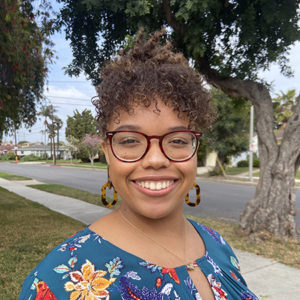
Driven by Questions
Taylor Montgomery aims to let her curiosity guide her as she embarks on a career in sports science.
BY KATHARINE GAMMON
May 11, 2021
Taylor Montgomery MS ’21 IS DRIVEN by questions.
When she was little, she would always press her mother with queries, wondering why and how the world worked. An educator herself, Montgomery’s mother always nurtured her daughter’s curiosity. When the family would go to bookstores, her mother would try to coax her to a fiction story, but Montgomery would gravitate towards the math workbooks. “My mom would be confused,” Taylor says, with a laugh. “No one in my immediate family was strong in math. But X plus Y equals Z — there’s a certainty.”
This constant sense of curiosity has kept Montgomery intellectually fulfilled, and now that Montgomery is set to graduate with a master’s degree in biokinesiology, she is ready to take her inquisitive nature to the next level.
Biokinesiology is a perfect match for her skill set, she says: she’s always been drawn to solving problems using math. But, the sports aspect is more of a stretch.
“I’m not someone athletically skilled. I did cheerleading when I was young — for like a day,” she says. “I played volleyball for a day, and that was the worst day in sports for me.”
Playing with Rockets
Montgomery attended an all-girls Catholic school, before getting accepted into Fisk University, a historically Black college in Nashville, Tenn., on a fully funded merit-based scholarship.
There, she joined her school’s rocket team and fell in love with building rockets. “It was inspiring to see a bunch of Black and minority students build rockets without engineering degrees,” she says. “It’s about problem solving.” She became the second woman ever to lead the team.
During college, she had an internship at East Carolina University in biomechanics, which applied her physics acumen from the rocket team to humans — and even better, because “humans talk back to you, and I like that.”
After having received funding through a National Institutes of Health research training program for individuals from underrepresented groups, Montgomery reached out to Associate Professor of Clinical Physical Therapy Susan Sigward PhD ’04 at USC to see if there were any learning opportunities. It turned into a summer of tinkering with wearable technologies, and the experience helped shape her.
“Even from day one, she was like, cut out the imposter syndrome,” Montgomery recalls about her tough-love mentor.
After her summer working with Sigward, Montgomery knew USC was the place she wanted to be, even though it was a different learning environment than the ones she’d known growing up. “I’ve had a predominantly Black education up to USC,” she says. “It’s different in that this is the most diverse place I’ve ever been. But I’ve grown a lot meeting new people from different cultures.”
From Rockets to Racecars
One field in which Montgomery is interested in working is auto racing — specifically Formula One racing. It might seem like Formula One drivers are just sitting in a car, but they’re actually athletes, Montgomery says. “They will drive around a corner going over 100 miles per hour, and the gravity they experiences is magnitudes greater than their body weight. That takes athletic ability.”
During her studies at USC, Montgomery did a project using wearables to assess driver performance and found that most resources were put into the car, instead of the athlete controlling the car. “In Formula One, I don’t know if there’s anyone who exclusively functions as a sports scientist for the athlete driving the car.”
In the next decade, Montgomery doesn’t know where she’ll find herself — she’s still developing skills that can be applied across different fields, but she’s sure her curiosity will guide her through. This summer, she has a fellowship to explore different parts of sports and technology. “I see myself as growing and being successful on my own terms and still giving back to mentor and recruit minorities like myself. I think I will only be the only woman or the only Black woman in most places I reach.”
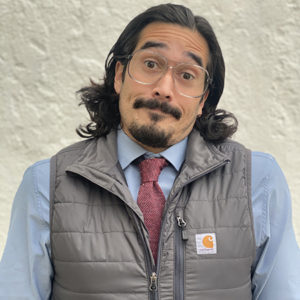
Faster Than a Speeding Bullet
DPT student Alberto Galvan aims to use his PT superpowers to serve others.
BY MICHELLE McCARTHY
May 10, 2021
ALBERTO GALVAN, A DPT STUDENT ON THE HYBRID PATHWAY, grew up without a father.
Lacking a male figure to look up to, the soon-to-be graduate instead modeled himself after superheroes.
“I knew they had to be strong, courageous, selfless people who were always helping,” Galvan recalls. “I played high school football and loved strength training. I trained all the time, but I kept getting hurt. Unlike Batman, I didn’t have an Alfred to mend my injuries, so I got into sports medicine and then the natural progression was to physical therapy.”
Much like the good guys you’ll find in comic books, Galvan sprung into action — Pow! — once the pandemic hit, and he saw a way to pitch in and help. First, he established the Driveway 5K, which helped raise money for the Keck Medicine of USC COVID-19 Emergency Response Fund.
“Just as other things started to transition to the virtual realm, I thought, ‘What if we could do a Zoom and everybody’s joining in and participating in the 5K?’ I wanted to bring people together in a way that was unconventional. We’re hybrid students; the online medium is how we do things, so, why not embrace tech in the same way this program uses it?”
After the resounding success of the 5K, which engaged both faculty and students, Galvan developed an online 60-minute exercise class called Hurt by Burt: Online Training, which took place three times a week via Zoom. Using a satellite CrossFit gym in his garage, Galvan took viewers through warm-ups, stretches and exercises.
“It was an opportunity to practice telehealth before we were actually in clinic and doing it,” Galvan says. “The hybrid program guided me in terms of modeling. I modeled what I learned from the program, such as offering breakout rooms and utilizing different methods to keep people interested. I also got to practice my exercise prescription and warm-up skills.”
Dark Knight, Silent Leader
While Galvan never viewed himself as a leader, this experience made him realize there is more than one way to lead. “I’m not usually the first one to raise my hand. I’m quiet and I watch,” he explains. “But if there’s a need, and no one’s stepping up, I’m going to do it.”
As he’s set to graduate this spring, Galvan can’t help but look back on his journey, one filled with obstacles and challenges along the way. “I applied to the USC physical therapy program four or five times before I was finally accepted,” he says. “I didn’t give up. I knew I wanted to do it, and I knew I wanted to do it at USC. I knew it would happen at some point.
“When you don’t succeed, you have to reflect on how you could do it different,” he continues. “Being at clinicals and working with patients, a lot of that personal growth within those five years really made it easier for me to talk to people who are going through obstacles and injury.”
Galvan attributes his never-take-no-for-an-answer approach to the women in his family. “My grandmother was an immigrant from Mexico, and my mom was a single mother. I was always around resilient women. Not having a male role model at home was a blessing because the women in my family don’t give up. They definitely passed that along.”
PT Summer Camp
For Galvan, his favorite memory from the DPT program, without question, is the immersions, which he likens to “PT camp.” “You’ll always remember summer camp,” he says, with a smile. “I will always remember immersions. I really got to know my cohort. We spent all day together. We ate together, cried together and shared the blood, sweat and tears. Sometimes we’d be there from daybreak to twilight, just cramming and studying and bonding. My heart gets mushy thinking about the fact that it’s all over.”
There is a long list of faculty members who Galvan cites as having a huge influence on him.
“I model my gestures and behaviors off of things I see successful people do — Dr. Beth Fisher, Dr. Christopher Powers, Dr. Michael Andersen, Dr. Liz Poppert and Dr. Daniel Kirages,” he says. “We weren’t physically on campus learning these skills until immersion, but using the videos, I tried to model and emulate what I thought would work really well in person — everything from hand placements to the way these professors would interact with their staged actors. Everybody taught me something. I really looked up to all of our professors.”
As for the future, Galvan plans to pursue a career in orthopedics and is looking into applying to Kaiser Permanente’s Orthopaedic Physical Therapy Residency. “Dr. Kirages has been counseling me on that,” Galvan says. “He’s a mentor who’s guiding me toward that residency. I’m a lifelong learner. Wherever I end up, I’m always going to be learning and growing.”

